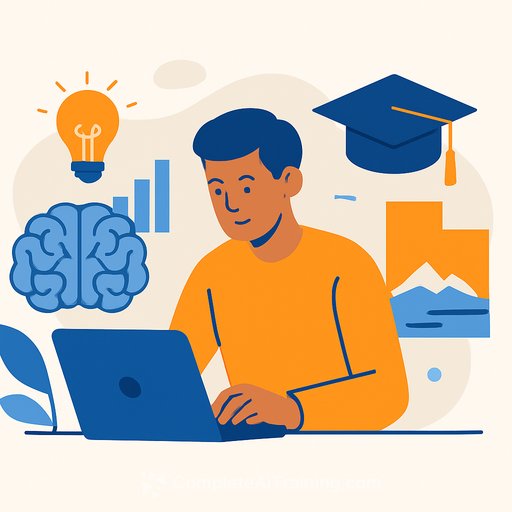Ecosystem: Redesigning Higher Education for an AI Economy
Lehi, Utah - November 10, 2025
Artificial intelligence is no longer a niche topic. It sits at the center of hiring, productivity, and how people learn at work. At Utah Valley University's event, AI in the Workforce: The Future of Human Work, Commissioner of Higher Education Geoffrey Landward laid out a direct challenge to our sector: evolve how we teach, assess, and credential - or fall behind those who do.
His message resonated with urgency without theatrics. The workforce is shifting faster than traditional academic cycles can handle, and students need applied experience, mentorship, and stackable skills that translate immediately.
The signal educators can't ignore
Landward cited the trend line that every dean, provost, and department chair should have on their desk. Ninety percent of employers identify AI, machine learning, and automation as critical worker skills. Sixty-seven percent are adding jobs that require AI. Job postings asking for AI skills are up 84% from 2023 to 2025. And 44% of core workforce skills are expected to change within five years.
Independent research points the same way. The World Economic Forum's Future of Jobs report shows a steady shift toward analytical thinking, tech literacy, and systems problem-solving - with continuous learning as the throughline for employability. Source.
From classrooms to applied studios
Landward's core proposal is simple: move learning into real contexts. Think students and faculty embedded with industry partners, using AI tools to fix actual problems - not just studying AI as a topic. He offered a practical example: a Utah manufacturer working with a college team to reduce waste and increase precision with AI-assisted systems.
That setting develops what employers can't automate: mentorship, judgment, collaboration, and creative problem-solving. It also produces evidence of work - portfolios, artifacts, and outcomes - that beat abstract transcripts.
The "experiential university" concept
Landward floated a bold pilot: a sandbox university where conventions are set aside. Rethink how faculty spend time, how we measure performance, how students progress, and how industry engages. In this model, AI becomes an instrument students use to solve problems under faculty and expert guidance.
Credentialing would follow suit. Fewer broad degrees. More stackable microcredentials that learners add over time as the job market shifts. As Landward put it, you might keep a handful of core degrees and let everything else stack - so people can return, update, and keep moving.
What stays human
Technical skills matter - but they age fast. Landward emphasized the durable side: teamwork, leadership, emotional intelligence, and the ability to learn, unlearn, and relearn. He pointed to the Socratic method from his law training: take a position, get challenged, refine your thinking. That habit builds decision-makers, not just task-doers.
General education still has a place - with a clearer link to work. "Facts are easy to learn," he noted. "Critical thinking is knowing how to challenge them." That's the backbone of effective AI use.
Utah initiatives already in motion
- K-12 CTE pathways: New AI-focused courses and teacher endorsements, backed by a $250,000 investment.
- Higher education credentials: AI-focused certificates, apprenticeships, and degrees mapped to regional workforce needs, supported by $1,000,000.
- Student commercialization and research: Funding to help students turn AI ideas into real products and services, with $250,000 allocated.
- Emerging AI workforce training: AI user credentials and bootcamps for incumbent workers, funded at $2,000,000.
- Curriculum modernization: $500,000 to accelerate AI integration across programs that serve priority industries.
As Landward acknowledged, the investments are meaningful - and still not enough at the pace we face. The model must change with them.
What you can implement this year
- Build applied partnerships: Place cross-disciplinary student teams with local employers on 8-12 week problem sprints. Require deliverables and reflection.
- Adopt stackable microcredentials: Convert high-enrollment course clusters into skills-backed badges that ladder into degrees. Tie each microcredential to a portfolio artifact.
- Make AI a horizontal: Add AI usage, critique, and prompt-writing labs in general education and major gateways. Focus on judgment and error analysis, not just tool use.
- Reward mentorship: Redirect a slice of faculty load to coaching student teams and industry projects. Recognize mentorship outcomes in promotion criteria.
- Assess with evidence: Replace a portion of exams with case write-ups, code notebooks, prototypes, and data stories students can hand to employers.
- Upskill the current workforce: Offer weekend or evening AI user credentials for teachers, staff, and regional employers. Provide CE credit and clear outcomes.
- Pilot a sandbox: Start with one college or center. Shorten approval cycles, co-design with employers, and publish outcomes every term.
- Track ROI: Monitor placement, wage gains, employer satisfaction, and time-to-credential. Use the data to refine the next cohort.
A shared responsibility
Dr. F. Wayne Vaught framed it well: universities are community resources, not just degree providers. People who can use AI will replace those who can't. That includes our students and the adults who need their next skill jump.
If you're building short courses or credentials for your region, look at Utah's public system for ideas and partnerships. Utah System of Higher Education.
For teams exploring structured AI upskilling by role, these curated paths can help you map needs to courses fast: AI courses by job.
The takeaway
We don't need to guess the future to act now. Make learning experiential, make credentials stack, and make mentorship the heartbeat. That's how higher education stays useful - and how our students, faculty, and communities keep winning in an AI economy.
Your membership also unlocks:






